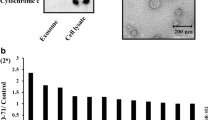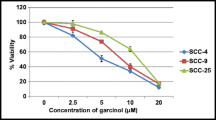Abstract
Heparin-binding protein 17/fibroblast growth factor binding protein-1 (HBp17/FGFBP-1, GenBank accession no. NP-005121) is prominent for its role as the chaperone for fibroblast growth factor-2 (FGF-2), which plays a crucial role in angiogenesis as well as promoting tumor growth. HBp17/FGFBP-1 has been proposed as a candidate biomarker for a number of cancers since it is frequently found to be elevated in many cancer types including in the tissue and cell lines of oral squamous cell carcinomas (OSCC). Previously, we reported that 1α,25(OH)2D3 suppressed the HBp17/FGFBP-1 expression in OSCC by inhibiting nuclear factor-kappaB (NF-κB) expression via vitamin D3 receptor (VDR). In this paper, to further characterize the inhibitory effect of 1α,25(OH)2D3 on HBp17/FGFBP-1, we examined the cellular localization of HBp17/FGFBP-1 protein and FGF-2 protein in the UE OSCC cell line. We found that the treatment of OSCC cells with 40-nM 1α,25(OH)2D3 suppressed HBp17/FGFBP-1 expression both in the nucleus and cytosol and reduced FGF-2 release into the culture medium. The expression of HBp17/FGFBP-1 and FGF-2 was analyzed by immunofluorescence and enzyme-linked immunosorbent assay (ELISA). In summary, the ability of 1α,25(OH)2D3 to suppress the expression of HBp17/FGFBP-1 and FGF-2 strongly suggests a therapeutic potential as a molecular-targeted anticancer drug for FGF-dependent cancers.


Similar content being viewed by others
References
Abuharbeid S, Czubayko F, Aigner A (2006) The fibroblast growth factor-binding protein FGF-BP. Int J Biochem Cell Biol 38:1463–1468
Amalric F, Bonnet H, Brethenou P, Roman A-M, Truchet I, Quarto N (1994) Fibroblast growth factor-2 (FGF-2) in the nucleus: translocation process and targets. Biochem Pharmacol 47(1):111–115
Baldin V, Roman A-M, Bosc-Bierne I, Amalric F, Bouche G (1990) Translocation of bFGF to the nucleus is G1 phase cell cycle specific in bovine aortic endothelial cells. EMBO J 9(5):1511–1517
Begum S, Zhang Y, Shintani T, Toratani S, Sato JD, Okamoto T (2007) Immunohistochemical expression of heparin-binding protein 17/fibroblast growth factor-binding protein-1 (HBp17/FGFBP-1) as an angiogenic factor in head and neck tumorigenesis. Oncol Rep 17:591–596
Bouche G, Gas N, Prats H, Baldin V, Tauber J-P, Teissie J, Amalric F (1987) Basic fibroblast growth factor enters the nucleolus and stimulates the transcription of ribosomal genes in ABAE cells undergoing G0----G1 transition. Proc Natl Acad Sci U S A 84(19):6770–6774
Czubayko F, Liaudet-Coopman ED, Aigner A, Tuveson AT, Berchem GJ, Wellstein A (1997) A secreted FGF-binding protein can serve as the angiogenic switch in human cancer. Nat Med 3:1137–1140
Fabricant RN, DeLarco JE, Todaro GJ (1977) Nerve growth factor receptors on human melanoma cells in culture. Proc Natl Acad Sci U S A 74:565–569
Gorugantula LM, Rees T, Plemons J, Chen HS, Cheng YS (2012) Salivary basic fibroblast growth factor in patients with oral squamous cell carcinoma or oral lichen planus. Oral Surg Oral Med Oral Pathol Oral Radiol 114:215–222
Hannneken A, Ying W, Ling N, Baird A (1994) Identification of soluble forms of the fibroblast growth factor receptor in blood. Proc Natl Acad Sci U S A 91:9170–9174
Harant H, Wolff B, Lindley LJ (1998) 1Alpha, 25-dihydroxyvitamin D3 decreases DNA binding of nuclear factor-kappaB in human fibroblasts. FEBS Lett 436:329–334
Harfouche G, Vaigot P, Rachidi W, Rigaud O, Moratille S, Marie M, Lemaitre G, Fortunel NO, Martin MT (2010) Fibroblast growth factor type 2 signaling is critical for DNA repair in human keratinocyte stem cells. Stem Cells 28(9):1639–1648
Kawakami A, Hirayama K, Kawakami F, Kawakami H, Fujihara M, Ohtsuki K (2005) Purification and biochemical characterization of a fibroblast growth factor-binding protein (FGF-BP) from the lactoferrin fraction of bovine milk. Biochemica et Biophysica Acta 1760(3):421–431
Kurtz K, Aigner A, Cabal-Manzano RH, Butler RE, Hood DR, Sessions RB, Czubayko F (2004) Differential regulation of a fibroblast growth factor-binding protein during skin carcinogenesis and wound healing. Neoplasia 6:595–602
Liu X, Shi S, Chen JH, Wu D, Kan M, Myoken Y, Okamoto T, Sato JD (2001) Human fibroblast growth factor-binding protein HBp17 enhances the tumorigenic potential of immortalized squamous epithelial cells. Anim Cell Technol: Basic Appl Asp 12:343–352
Marie M, Hafner S, Moratille S, Vaigot P, Mine S, Rigaud O, Martin MT (2012) FGF2 mediates DNA repair in epidermoid carcinoma cells exposed to ionizing radiation. Int J Radiat Biol 88(10):688–693
Miyauchi S, Murayama T, Koizumi S, Asakawa J, Okamoto T, Takada K (1988) Malignant tumor cell lines produce interleukin-1-like factor. In Vitro Cell Dev Biol 24:753–758
Mongiat M, Otto J, Oldershaw R, Ferrer F, Sato JD, Iozzo RV (2001) Fibroblast growth factor-binding protein is a novel partner for perlecan protein core. J Biol Chem 276:10263–10271
Okamoto T, Tanaka Y, Kan M, Sakamoto A, Takada K, Sato JD (1996a) Expression of fibroblast growth factor binding protein HBp17 in normal and tumor cells. In Vitro Cell Dev Biol Anim 32:69–71
Okamoto T, Tani R, Yabumoto M, Sakamoto A, Takada K, Sato GH, Sato JD (1996b) Effects of insulin and transferrin on the generation of lymphokine-activated killer cells in serum-free medium. J Immunol Methods 195:7–14
Rosli SN, Shintani T, Hayashido Y, Toratani S, Usui E, Okamoto T (2012) 1α, 25(OH)2D3 down-regulates HBp17/FGFBP-1 expression via NF-кB pathway. J Steroid Biochem Mol Biol 136:98–101
Sato JD, Kawamoto T, Okamoto T (1987) Cholesterol requirement of P3-X63-Ag8 and X63-Ag8.653 mouse myeloma cells for growth in vitro. J Exp Med 165:1761–1766
Takeuchi A, Yoshizawa N, Yamamoto M, Sawasaki Y, Oda T, Senoo A, Niwa H, Fuse Y (1992) Basic fibroblast growth factor promotes proliferation of rat glomerular visceral epithelial cells in vitro. Am J Pathol 141:107–116
Tassi E, Al-Attar A, Aigner A, Swift MR, McDonnell K, Karavanov A, Wellstein A (2001) Enhancement of fibroblast growth factor (FGF) activity by an FGF-binding protein. J Biol Chem 276:40247–40253
Tassi E, McDonnell K, Gibby KA, Tilan JU, Kim SE, Kodack DP, Schmidt MD, Sharif GM, Wilcox CS, Welch WJ, Gallicano GI, Johnson MD, Riegel AT, Wellstein A (2011) Impact of fibroblast growth factor-binding protein-1 expression on angiogenesis and wound healing. Am J Pathol 179:2220–2232
Wu DQ, Kan MK, Sato GH, Okamoto T, Sato JD (1991) Characterization and molecular cloning of a putative binding protein for heparin-binding growth factors. J Biol Chem 266:16778–16785
Acknowledgments
This research was supported in part by Grants-in-Aid for Scientific Research from the Japanese Ministry of Education, Culture, Sports, Science and Technology to T.O. (grant number 24390456) and T. S. (25463109). The authors thank Dr. J. Denry Sato for editorial assistance.
Author information
Authors and Affiliations
Corresponding author
Additional information
Editor: T. Okamoto
S. N. Zawani B. Rosli and Tomoaki Shintani contributed equally to this work.
Rights and permissions
About this article
Cite this article
Rosli, S.N.Z.B., Shintani, T., Toratani, S. et al. 1α,25(OH)2D3 inhibits FGF-2 release from oral squamous cell carcinoma cells through down-regulation of HBp17/FGFBP-1. In Vitro Cell.Dev.Biol.-Animal 50, 802–806 (2014). https://doi.org/10.1007/s11626-014-9787-5
Received:
Accepted:
Published:
Issue Date:
DOI: https://doi.org/10.1007/s11626-014-9787-5




